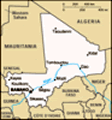Advertisement
Published: June 23rd 2017
Geo: 16.7721, -3.00778
Given the encroaching desert, the Niger doesn't quite make it to Timbuktu anymore (although there is an effort underway to re-establish that link). As a result we had to catch a shuttle to the town itself- the driver was only too happy to inform us that we were now officially in the middle of nowhere- we were also able to get the needed picture in front of the sign pointing to Timbuktu. We had to struggle to find a suitable sign and in this respect, Timbuktu remains surprisingly untouched by the kitch that seems to afflict similar destinations. We didn't see any “I made it to Timbuktu T-Shirts”, plastic camels, or any other tacky souvenirs- we were accosted by the occasional Tureg tribesman selling ‘authentic‘ jewellery but as often as not they would be outed by the locals as Turegs in drag and forced to beat a shameful retreat. The only blatant concession to tourism seemed to be the camel safaris into the desert that were constantly on offer (to the dunes and/or a Tureg camp). Being the camel snobs we are, with a multi day camel trek in India under our belts- where we controlled our own animals-

 The Mddle Of Nowhere
The Mddle Of Nowhere
We were asked a couple of times as to whether or not this was our first time in Timbuktu.we debated the bucket-list worthiness of a one hour walk into the Sahara with the camel being led by its handler, and decided to pass.
Useless fact: The literal translation of Timbuktu is “the well of the women with the large navel“? Not a great match with a town of mystery and intrigue.
So what was Timbuktu? For me it matched my expectations of a tough town, populated by tough people sitting on the edge of one of the harshest environments there is- the all consuming Sahara Desert. In its current form it seems the unlikely child resulting from the forced union of Arabia and Africa in a Tombstone, Arizona-like setting. It's definitely a town that has only distant memories of it's glorious past as a wealthy trading centre (gold, slaves, ivory were sent north and salt came south)- it's ‘best by' date has come and gone, and it still seems, through the people, to have a palpable pride in being that lone sentry charged with holding back the Desert. On that score, however, I'm not sure who's winning- save for a couple of semi-paved streets, the desert sand fills most of the others. Motorcycle riders have mastered the art of the
controlled fishtail, and the rest of us just accept that we'll have to empty our shoes of sand every half hour or so.
In it's prime, Timbuktu drew numerous Islamic scholars which began a great tradition of education and thought, so our own adventure started with an effort to visit a couple of the libraries that currently house many of the ancient manuscripts. The opening hours were apparently more of a suggestion than a commitment so we changed gears and wandered off to visit a couple of the mud mosques that are among the oldest mosques in West Africa- along the way we found the regional tourism office and obtained the requisite ‘Timbuktu' stamp in our passports (I hope this doesn't come back to bite me as I'm very short on space in my passport and this stamp took up some valuable real estate).
I'm not sure of the melting point of titanium but Tibra must have been having some near death experiences as we continued our walk outside of the town limits and into the Sahara itself- I've gained a whole new appreciation for those cartoon characters who are pictured crawling toward the oasis mirage after days without water- I
was taking a drink about every 100 feet. But we did it- stuck our toe into the Sahara Desert, took a few pictures as proof, and headed back to the relative cool of Timbuktu (how many times can you say that 37C was relatively cool). As we meandered, we ended up in the middle of the Petite Marche (small market) which, of course, was much larger than the Grand Marche (big market) we had seen earlier in the day. Raging heat combined with fly-covered meat hanging on hooks or fish displayed on the ground- think of the wonderful scents emanating from this market. DH and I continued with our games of ‘name-that-fruit/nut/berry' or ‘what-the-hell-is-that?' as we squeezed around the various small stalls with all eyes on us.
The hotel we stayed at had a small foot pool in the lobby area, which we found a bit odd when we first checked in but it became our own personal oasis beacon where we brought our body temperatures back down and out of the red zone.
One more night in Timbuktu during which DH, through self diagnosis, has contracted malaria-her feet slipped out from under the mosquito netting and she noted some bug bites
in the morning although, according to Dr DH we'll need to wait 7 days to be certain. With soon-to-be malaria victim in tow we started our return trip to Mopti by road using a 4x4- not only was this quicker (1 day), but you gained the real-life experience of just about any fruit/vegetable inside of a blender.
Advertisement
Tot: 0.055s; Tpl: 0.012s; cc: 7; qc: 33; dbt: 0.0239s; 1; m:domysql w:travelblog (10.17.0.13); sld: 1;
; mem: 1.1mb























